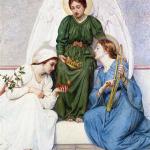 Over at Shrine of the Holy Whapping Drew was asking if anyone knew the origin of the bishop’s mitre. It reminded me that purveyors of the more wacky anti-Catholic propaganda believe the bishop’s mitre is derived from the ancient pagan religion of Dagon the fish god. (picture to the left) See how the priest’s headgear looks remarkably like a mitre? The tabs that hang down the back of the bishop’s mitre (they’re called lappets) are obviously the vestigial remains of what was a full blown fishy-type cloak.
Over at Shrine of the Holy Whapping Drew was asking if anyone knew the origin of the bishop’s mitre. It reminded me that purveyors of the more wacky anti-Catholic propaganda believe the bishop’s mitre is derived from the ancient pagan religion of Dagon the fish god. (picture to the left) See how the priest’s headgear looks remarkably like a mitre? The tabs that hang down the back of the bishop’s mitre (they’re called lappets) are obviously the vestigial remains of what was a full blown fishy-type cloak.
There’s a fair bit of this material on the web, and I have to confess, I have a weakness for the stuff. I’m a sucker for bogus scholarship, way out conspiracy theories, arcane connections and obscure explanations. Yetis, alien kidnappings, miracles…’who really killed Princess Diana??’ you name it, I’m a fan.
I don’t really swallow too much of it. Instead, I’m fascinated by the sort of mentality that takes it all seriously. I’m intrigued by the border lands of sanity, and often feel that a large proportion of our fragile human race are seriously crazy. Their loopiness (and maybe my own-am I crazy too) is fascinating because they clearly cope well enough in ordinary life not to be locked up, but if being insane means they have a seriously slanted view of reality, then they must be a few sandwiches short of a picnic.
Do you want to be a ‘spot paganism in Catholicism’ loony? All you need to do is find some sort of similarity between a pagan religion and Catholicism. The Egyptians worshipped the sun god, so its easy to see how the rising Son of God in Catholicism is really paganism right? Dagon’s priests wore pointy hats so the bishop’s mitre must have come from that. You don’t need any real scholarship or any thing so objective as a fact because the real facts, of course, were covered up by the all powerful Catholic authorities. Pagans had mother godesses so Catholic veneration of the Blessed Virgin Mary shows that Catholicism is just the old pagan Earth mother worship.
The curious thing about conspiracy theories is that they usually do contain some truth. That’s why they’re intriguing. There’s just enough truth mixed with innuendo and half truths to make you say, “By gosh, I think they’re on to something! Maybe the twin towers really did explode from the inside just before the planes hit!!”
So it is with Catholicism. It was not a secret that the early church picked up certain pagan practices and dates and baptised them. It was part of their missionary strategy to build churches over the old pagan sites, and transform what was useable from the old religion. The links with the old religion are everywhere in Catholicism, and if you want to get rid of them you’d better join the Jehovah’s Witnesses. That’s why they don’t have crosses (its really the Egyptian ‘tau’ sign you know) and they don’t celebrate Christmas (its really the ancient winter solstice celebration…)
On a deeper level, the fact that Christianity has similarities to paganism is a mark of it’s authenticity, not a mark of its being a fraud. If the Christian message is true, you would expect it to connect with everything else that is true. It will therefore connect with certain elements of all the other world religions. More than that–it fulfills all the other world religions. Just as Judaism is completed and amplified by the New Covenant, so Christianity completes and amplifies all the world religions that went before it.
Does the bishop’s mitre really, really descend from the headgear of the ancient preists of Dagon? I doubt it very much, (here’s the true lowdown) but even if some scholar uncovered an ancient manuscript tomorrow in which Pope Whathisname in the second century said, “Brothers and sisters, since we follow ICTHUS the fish, let us adopt the ritual headgear of Dagon” there wouldn’t be a problem. We’d just say, “Well praise the Lord for that, we don’t worship any old fish god anymore. Neither do we worship the bishop, but isn’t it kinda neat that they thought to hook up with what went before?”















